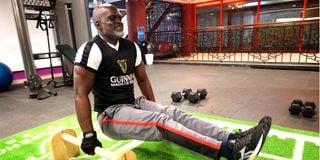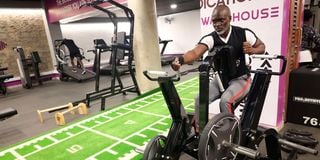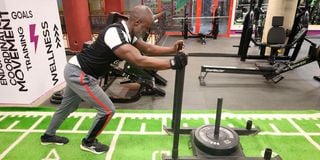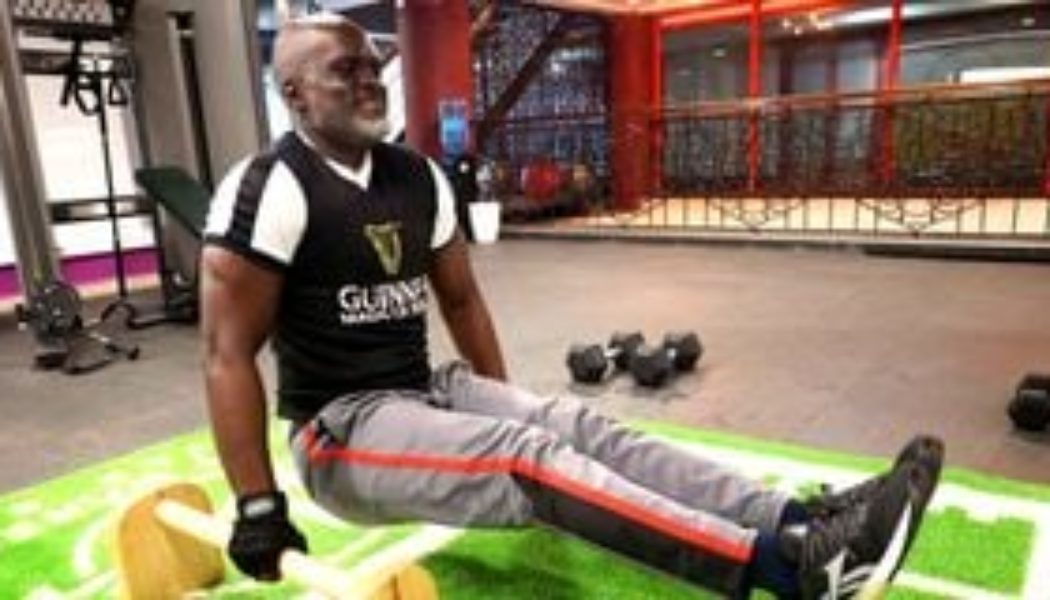Lewis Amoko doesn’t grind away at the gym like everyone else, yet his sculpted physique consistently turns heads. At 43, Amoko is rewriting the rules of fitness for the over-40s by focusing on longevity rather than intensity.
“At my age, it’s about working smart, not hard,” he says, noting that this shift has allowed him to keep training longer.
He elaborates, “Once you hit 40, the risk of injury increases, so I’ve built a sustainable routine that lets me keep going.”
It’s a principle rooted in patience, balance and a willingness to adapt.
Lewis’ approach is as calculated as it is unconventional. His weekly workout regime totals only three hours, all dedicated to strength training, with a strict 24-hour rest period between sessions.
This commitment to recovery is non-negotiable.
“Research shows that beyond 40, your cartilage—the cushioning for your joints—starts to lose water, becoming more prone to wear and tear,” he explains and adds,“Tendons also dry out and stiffen, making injuries more likely if you push too hard.”
For Lewis, that extra day of rest isn’t a luxury—it’s essential to his progress. “I need those 24 hours to ensure my body fully recovers before each workout, maximising both the safety and benefits.”
On his off days, he makes a habit of walking to stay active without stressing his body. “At my previous workplace, I’d walk to work, about 25 minutes each way,” says the banker.
“I’d keep a steady pace so I wouldn’t break a sweat. My new job is a bit farther, but I still walk when I can. These walks are my go-to on days I’m not lifting weights, helping me stay active and energised.”

Lewis Amoko works on L-sit on parallettes at the Workout Warehouse Gym in Nairobi on October 23, 2024.
Photo credit: Evans Habil | Nation Media Group
Balance and efficiency
Lewis’ workouts differ from most people’s. With workouts on alternate days, he focuses on getting the most out of every minute.
“An hour per session is ideal,” he explains. “Some would argue that three hours a week isn’t enough for significant gains, but with age, you need a smarter approach.”
Lewis maximises his three weekly hours with moderate weights, shorter rests, and an intense focus on form.
“I keep the workouts intense, with moderate weights and shorter rests between sets,” he says.
He understands the importance of proper technique, which he says many younger lifters often overlook.

Lewis Amoko works on a seated row machine at the Workout Warehouse Gym in Nairobi on October 23, 2024.
Photo credit: Evans Habil | Nation Media Group
“Using moderate weights with perfect form is essential. As you age, focusing on correct technique and rest prevents injuries and helps you get the most out of each workout,” he emphasises.
Balanced diet without sacrifice
Despite his toned physique, Lewis doesn’t follow a strict or complex diet. He keeps his eating habits straightforward, avoiding processed sugars and committing to whole, natural foods.
“I don’t do processed sugar at all,” he says.
Instead of following a strict diet, he follows a few simple rules. Every day, he eats four whole fruits—never as a fruit salad, as he believes in eating each fruit individually to get the most out of it.
“The idea is to enjoy the natural benefits of each fruit,” he explains.
He also prefers eating his main meals earlier in the day to have a lighter supper if needed. “I try to have my meals early, which helps me avoid feeling too heavy at night.”
Another adjustment he has made is reducing his alcohol intake, an important choice for him to stay aligned with his wellness goals. This flexible but intentional approach to food helps Lewis fuel his workouts and maintain his lean physique without feeling deprived.
A 20-year fitness journey
Lewis’ fitness journey spans two decades. “It’s been 20 years of on-and-off training, though I’ve managed to stay consistent for the last 10 years,” he shares.
His lean physique and visible muscle tone are the result of dedication, not endless hours in the gym.
“Consistency is key, and exercising twice or thrice a week has allowed me to maintain that,” he emphasises.
Growing up in Nairobi’s Eastlands neighbourhood, he was part of the Mathare Youth Sports Association (MYSA) Academy, where he found his love for fitness.
“Football was our lifestyle, and after high school, joining MYSA was the next step,” he recalls.
It was there that he and his friends set up a makeshift gym, using what they had to work with.
“We made concrete dumbbells and pieced together a bench from wood. We even rigged a T-bar with rusty metal bars. It wasn’t perfect, but it did the job and gave us a sense of discipline and dedication,” he says with a smile.

Lewis Amoko pushes a weighted sled with 40-kilogramme plates at Workout Warehouse Gym in Nairobi on October 23, 2024.
Photo credit: Evans Habil | Nation Media Group
That early exposure to strength training left a lasting impression, particularly on his arms.
“I know my arms are big,” he chuckles. “Back then, dumbbells were easier to make than most other equipment, so we used them more often. Those early sessions with DIY weights left a mark.”
Fitness beyond the gym
Today, as a father of two with a demanding job, Lewis knows firsthand the challenge of balancing fitness with life’s many responsibilities.
“Once you have a family and career, it’s easy to let exercise slip,” he admits. “But you have to make time deliberately. It’s why I keep my routine at three hours a week—short, sustainable, and manageable with everything else in my life.”
He’s found that by focusing on quality over quantity, he can stay consistent without sacrificing time with his family or work commitments.
By working within his limits and respecting his body’s changing needs, Lewis says he’s setting himself up for lifelong health and vitality. With the right mindset and approach, he says staying fit at any age is entirely achievable, and it doesn’t require hours in the gym or restrictive diets. Instead, it’s about making choices that support one’s well-being for years to come.
And for Lewis what he is looking foward to is enjoying every minute of his next 20-year fitness walk.









